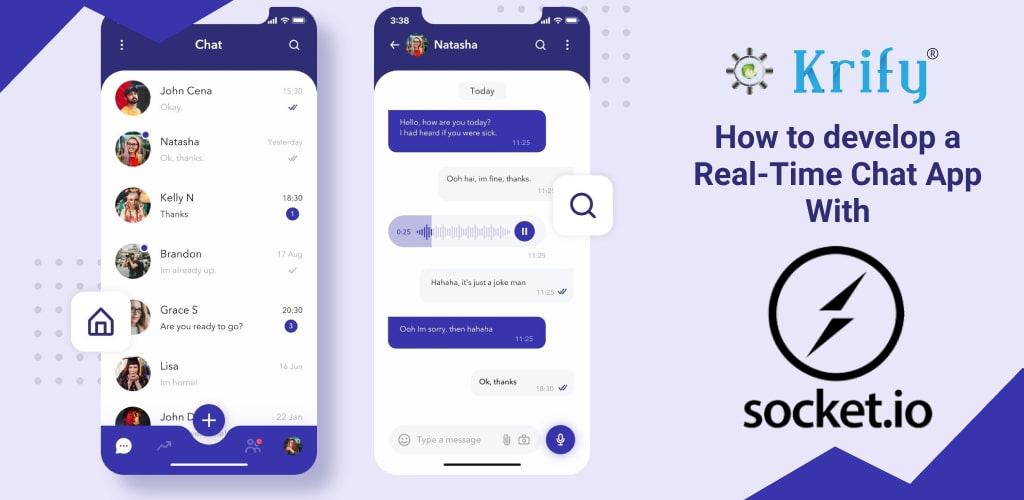How to develop a Real-Time Chat App? Real-time apps surround us all, and people already chat over big social media website such as Facebook or Twitter. Messages are sent immediately, and feedback is received in real-time. While your buddy types on the keyboard, and when he finishes, he sees it. As soon as someone touches the contact, you see your tweets returned and liked.
Socket.IO facilitates the creation of chat apps with real-time, two-way event-based communication. It falls under the Realtime Backend/API category and aims to provide a standard API similar to WebSockets for browsers and computers. WebSocket offers a low-latency, full-duplex networking protocol between the server and the browser, establishing a connection that remains open if the browser supports WebSockets, unlike standard HTTP requests.
Chat app development using Socket.io
To develop a chatting app using socket.io, It is necessary to know HTML, CSS, JavaScript, JQuery, Node.js. Node.js been installed on your local machine to build a chatting app using socket.io.
Requirement
Node.js to be installed on your local machine to build a chatting app using socket.io.
Setup an Express Server:
To set up the node project directory, begin by creating an empty directory and adding initial files such as index.js to boot the server and package.json. Next, start an Express server in the index. js file. The Socket.io library requires a server from the main HTTP module of Node. Thus, developing a server in this file differs from the standard Express server file.
Build the UI for Chat
- Let us develop a fundamental HTML framework to look at the chat app. Build a new public directory and create a new index.html file within. This file acts as the point of entry for every web browser user.
- The container serves as a root div element. The application features a header, and a chat function comprises a chat window displaying the messages, with an entry for entering and sending the chat message itself. Both components have matching class names and are styled using simple CSS.
- Finally, add to this file two script tags. The first script tag ensures that the io object is accessible to the recipient. Thus the server will be aware that the socket connects a client.
- Create a public directory script.js file and apply this declaration to it at present. To see the web page in action, edit the path in Index.js.
- Express. Static is used to serve the index.html static format. Return to the Terminal now. If the server works, restart it and, otherwise, just type index.js node. And ensure that Nodemon is used in development mode.
Add Socket.io library
- It would be best if you imported the Socket.io library into index.js to create the chat app. After that, start the Node server library.
- The io entity sends out events and detects them. You might have observed io. in an event to bind to a socket and transfer the socket to the callback method as the statement. The chat app’s server can execute the console.log() message when the client is connected.
The client sends a message to the server
- Ensure two points to make the form work.
- Prevent reloading a website
- Read the message and send it with the Socket; read the input value from the input field.
- You would then need to choose the chat entry to transmit either the input field value or the chat message using sockets. Additionally, you must ensure that the chosen method seamlessly integrates with the socket communication protocol.
- The socket. emit() is the client sending process. The event (chat) is the first parameter, and the value (input field value) is the second parameter.
- Now, go to the index.js server file and listen to a message the client sends via socket. on(). For this program, you can listen to the client’s chat case listener.
- Restart the server and send a new message to the browser window.
Send all client’s messages to the server
- Add the message transmission capability to the whole chat room. In other words, at present, any user connected to the socket port will receive the alert. Let’s start with the index.js API file first to incorporate this feature. Open and insert io.emit (). The client must have a way to listen to all events issued by the server. This procedure emits an event to all associated clients. Serve this by opening public/script.js and add the line after setting the chat event listener.
- Make sure that the server works. Simultaneously open two browser windows, and try sending a reply from one window as seen below. You will see that the message simultaneously sends from one window to all open browser browsers. Each client linked to the chat application server can use every message.
Add UI display to Chat message
- Let’s modify and build a simple user interface to view the client chat message instead of opening the Console tab on the development tools of a browser.
- Before the talk form, the index.html file displays an empty div tag with the class name chat-window.
- You can view all the chat messages using the class name. Open script.js after the existing event listener and apply the new method called RenderMessage().
- Now go to the windows of the browser and attempt to send a message.
Conclusion:
From the above development steps, We developed a first chat program in real-time. When you get how data flows in real-time, socket.io makes creating powerful apps super simple.
At Krify, we have a team of well-versed developers who are passionate about their skills and develop robust mobile and web applications based on the client’s requirements. If you are looking to develop a chatting app using socket.io, you are on the right page. For more information contact us.




